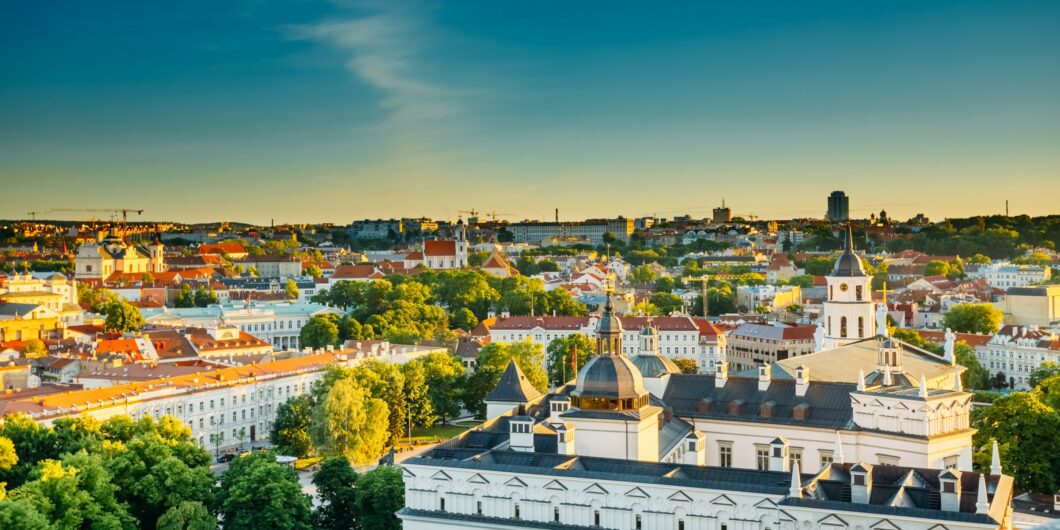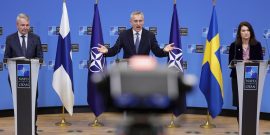The further expansion of NATO to include Finland and Sweden will lead to less, not more, security in Europe.
The Baltic Love of Freedom
The windswept Curonian Spit, on the Baltic Sea, affords a choice spot for reflecting on the turbulent twentieth century. It is part of Kaliningrad, Russia’s western exclave, though Lithuania possesses its northern end. From this spot, the mind naturally turns to the complexities of history, and the darkening geopolitics of our time.
From Klaipeda, Lithuania’s port city, it is accessible only by ferry. The narrow land strip, like the Baltic states as a whole, has witnessed the rise and fall of many empires, Nazi and Soviet ones not least. I found myself wandering on it during a research trip to the Baltics, investigating Soviet-era secularism and anti-religious repression. I learned a lot on these topics, but, more generally, I was impressed by Lithuania, Latvia, and Estonia’s plucky spirit of independence, the dire hardships their peoples’ have experienced, and their informed disquiet about Putin’s Russia today.
“The past is never dead. It’s not even past,” William Faulkner famously said. This might be true of all places, but it is achingly true of the Baltics. Friends of freedom ignore the lessons of their past only at great peril.
Escaping the clutches of imperial Russia after World War I, the three countries gained independence and the consolidation of national identities in the 1920s and 1930s.
The venomous fly in the ointment came with the Molotov-Ribbentrop Pact of August 1939. Also known as the Hitler-Stalin Pact or the Mutual Assistance Treaty, this accord gave Hitler carte blanche to invade Poland in September of that year, starting the Second World War. The Pact’s “secret protocols” (not officially recognized by the Soviet Union until 1989) made allowance for spheres of influence in Eastern Europe divided between Germany and the Soviet Union.
All three Baltic states wound up in the Soviet sphere, and the flame of freedom flickered out. Shortly after occupation in 1940, Stalin sought to decapitate the countries’ political leadership and intelligentsia. In June of 1941, roughly 11,000 people from Estonia, 15,000 from Latvia, and 17,500 from Lithuania were sent eastward to the Gulag or to forced resettlement communities. Routinely, Soviet police and security forces arrived in the middle of the night, forcing men, women, children, and the elderly into cattle cars for relocation. Many perished during the journey. Others died from subsequent hardships and deprivations. Meanwhile, the Sovietization of Baltic societies proceeded apace with the new ogreish Caesar shutting down non-governmental organizations, repressing religious institutions, and collectivizing land in the name of the “working people.”
Amid people laughing, singing, and weeping, Ukrainian flags filled the air at the rally, often paired with those of Baltic countries. Ukraine’s history is our history, I was told on several occasions.
The year 1941 also witnessed Operation Barbarossa and the Nazi Wehrmacht taking possession of all three states, driving Soviet forces out and setting in motion the machinery of the Holocaust. By December of 1941, the vast majority of Jews in Lithuania (200,000), Latvia (90,000), and Estonia (1,000) had been exterminated, often in hideous ways, at sites such as the Ninth Fort near Kaunas, Lithuania, which I visited. It does not excuse instances of Baltic complicity in these crimes, but that history can be better understood in light of the widespread fear that, save for the Germans (who deceitfully promised Baltic countries their independence), the Soviet menace would return.
And in 1944 it did return, with the shedding of much blood on both German and Soviet sides and with Baltic soldiers forcibly conscripted by both powers, tragically having to fight against one another.
Soviet victory meant the Baltics’ long subjugation during the Cold War. It also meant the return of arbitrary arrests and deportations, the massive collectivization of agriculture and elimination of wealthier peasants or “kulaks,” pervasive KGB-inspired terror, mandated learning of the Russian language, censorship of the press, a shambolic command economy geared toward Moscow’s needs, and, not least, renewal of the assault on religious institutions.
During my travels, I visited the Orthodox Church of the Nativity in Riga, Latvia, which was turned into a planetarium with a coffee bar during the Soviet era, and Saint Casimir’s Church in Vilnius, Lithuania, turned into a “museum of atheism” with exhibits vilifying all forms of religious commitment. I also made a trip to the “Hill of Crosses” in rural central Lithuania, a major site of pilgrimage and political resistance. The KGB bulldozed it three times in the 1960s and 1970s—leading scholars to characterize the era as one of “bulldozer atheism.” But each time, courageous Lithuanians re-erected crosses furtively at night. Eventually, the KGB gave up and let it stand. Pope John Paul II dignified the site with a visit in 1993.
The same spirit of defiance inspired the founding of the Chronicle of the Catholic Church in Lithuania in 1972, widely recognized as one of the most important samizdat publications of the Cold War in the entire Soviet Union. Run by dissident nuns and priests and translated into numerous languages, it documented thousands of cases of anti-religious persecution and other human rights abuses—a thorn in the side of Moscow until the annus mirabilis of 1989. It also inspired the comparably significant Chronicle of the Catholic Church in Ukraine.
In hindsight, we know that the Soviet Union collapsed. But in the 1980s that outcome was far from certain. Realizing this makes one admire all the more the unrest and defiance exhibited by the Baltic peoples during this time. Pushing Mikhail Gorbachev’s policy of glasnost (openness) to its limits, Baltic dissidents laid the groundwork for the return of civil society by agitating for environmental rights, human rights, and an honest reckoning with Soviet-era brutality. They pushed for the return of patriotic symbols and attitudes, long suffocating under the public pretense of politically correct Marxism-Leninism. Sometimes described as the Singing Revolution, due to the role that popular folk songs and festivals played in rekindling the desire for national independence, the events of the late 1980s culminated in the “Baltic Way,” an astonishing human chain of two million people stretching from Tallinn, Estonia to Vilnius, demanding the return of their countries from Moscow’s grip. This transpired in 1991, the year of the Soviet Union’s ignominious collapse.
All of this history no doubt played a role in the pro-Ukraine, anti-war rally I happened upon in Riga, Latvia. Staged in front of the Russian embassy near a destroyed Russian tank transported from Ukraine, the event brought together musical groups from across the Baltics to sing and raise money for the Ukrainian war effort. Recalling the memories of her grandmother, a woman at the rally explained to me her incredulity that the Russian threat had returned. But so it was: Putin, a wolf in wolf’s clothing. Amid people laughing, singing, and weeping, Ukrainian flags filled the air at the rally, often paired with those of Baltic countries. Ukraine’s history is our history, I was told on several occasions.
Bordering all three Baltic countries, Russia presents an existential threat. And though the ideology driving it has changed somewhat since Soviet times, comparable geopolitical interests are at stake. Russian opposition politician Mikhail Kasyanov warned already in 2022 that if Ukraine falls “the Baltic states will be next.” The quote is often repeated, and citizens of these states take it quite seriously. Geography does not explain everything in human affairs, but it does explain a lot.
Nor is it true that history never offers direct lessons. From my travels, reading, and talking with people, five possible lessons come to mind.
Proximity inspires fear, and fear in turn prompts action. Punching above their weight, Latvia, Estonia, and Lithuania rank respectively first, second, and fourth in aid to Ukraine as measured by a percentage of GDP. (Poland is third.) Collectively the size of Nebraska, the three countries have taken in their share of Ukrainian refugees and have been on the front lines advocating for persistent NATO, EU, and American involvement.
Memories of foreign occupation intensify the desire for freedom and heighten awareness of its fragility. “Freedom is not something that can be taken for granted. It must be constantly nurtured and protected,” as Kersti Kaljulaid, the President of Estonia, recently put it. Comparable statements loom large in utterances of Baltic leaders, and I heard them at the anti-war rally as well.
Thucydides’ maxim that “the strong do what they can and the weak suffer what they must” is not necessarily inevitable. The Baltic states offer remarkable examples of decades-long resistance against huge odds to larger foes and the steady forging of republican identities. Besides surviving Nazi and Soviet empires, these countries have survived past Polish, Russian, Swedish, and Prussian ones.
Present challenges to freedom cannot be understood apart from knowledge of the past. “The study of history is the beginning of political wisdom,” as Jean Bodin famously put it. Sadly, not only could most American young people not find the Baltic states on a map, but memory of the Soviet Union and the Cold War is rapidly declining. Knowledge of the Soviet occupation is slackening among Baltic young people today too, I learned, and, like many Western youth, some have been seduced by the specious virtues of socialism. Teaching the history of “real existing” socialism, not just its “theory” in Marxist texts might be the best antidote to youth’s latest folly.
Finally, we can see from the relatively peaceful revolutions toward democracy that the Baltic states helped initiate in the late 1980s that Marxist-Leninists and Maoists alike were wrong to insist that social change requires violence. Perhaps Pope John Paul II put it best in his encyclical Centesimus Annus (1991) when he wrote that the revolutions in and after 1989 were “accomplished almost everywhere by means of peaceful protest, using only the weapons of truth and justice. While Marxism held that only by exacerbating social conflicts was it possible to resolve them through violent confrontation, the protests which led to the collapse of Marxism tenaciously insisted on trying every avenue of negotiation, dialogue, and witness to the truth, appealing to the conscience of the adversary and seeking to reawaken in him a sense of shared human dignity.” For the Baltic countries, this also included singing.
Now more than ever, the Baltics’ recent history and current fragile freedom are worthy of remembrance. If Ukraine fails, we are sure to hear a lot more from and about these states. But if Putin is finally thwarted, Estonia, Latvia, and Lithuania will have deserved a word of thanks for enduring dark times and bearing witness to difficult truths, both in the past and now.



